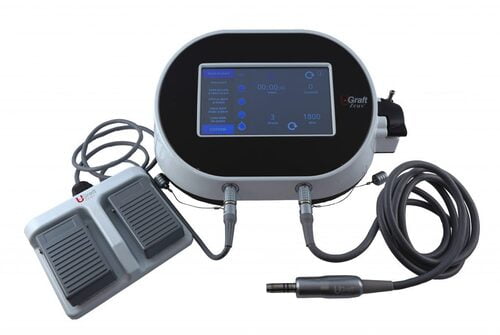A novel follicular unit excision device would be the one that offers solutions to all the problems; a transplant practitioner can face. From its discovery in the last decades of 18th century till 2022, hair transplant has evolved with time. Initially follicular unit strip surgery was introduced; by taking a strip of donor skin along with hair follicles and then extraction of follicles with subsequent implantation into the recipient area manually just using some dissecting instruments. As the decades & years passed this process has also passed its initial trial stages and now it is known as FUI & FUE. Both follicular unit excision (FUE) and follicular unit incision (FUI) are performed with special tools not with blades & tweezers with 90% success rate. Practitioners are still in the discovery phase of a novel follicular unit excision device that may help them to face all the challenges confidently. So, what these challenges really are? These are basically donor variables and may include location (head & body), long or short hair, and curliness of hair, race, and skin texture (soft and thin or rough and thick). Let’s discuss which improvements in FUE instruments can help us to overcome the problems.
By overcoming all the limiting factors of previously available ones and creating a novel follicular unit excision device is the best solution. All FUE instruments basically have 2 functions; a punch to cut the tissue and a punch driver which may be manual or mechanical to drive the punch cutting tip. The existing FUE machines don’t deal with donor variables successfully, making hair transplant unsatisfactory for many candidates. To reduce graft attrition, all-purpose punch is used in the novel follicular unit excision device. This punch technique also provides the minimum assist navigation (MAN); hallmark of best FUE machines. Outer beveled punch tip of old instruments; is more likely to cut the follicle before it reaches to the follicle level and also creates a large sized wound which heals by secondary intention leaving a prominent scar mark. New device with a flared punch cutting axis creates an inverted wound that heals by primary intention and a small scar respectively. As a punch advances along the deeper portions of the graft, the proximal portion of the graft is pulled into the rotating punch’s lumen. Any friction between the punch’s inner surface and the graft results in the punch and the intra luminal portion of the graft rotating in unison. This results in twisting the follicle at the junction between the rotating and stationary parts, ultimately leading to transaction. To minimize torsion induced transaction, this punch lumen should be transformed into a frusto-conical shaped cylinder by expanding its diameter relative to its cutting tip (1-2mm of the tip to 7mm). Talking about the higher graft attrition rate in North African people because of coracoids or loosely curled hair patterns. To avoid graft attrition because of subsurface angulations of hair the device should provide patent texturing along with MAN. In old FUE machines, pulling of hair follicle is done by vacuum suction; not responding well to changing thickness and firmness of skin and also pulls the body fluids; a challenge to sterilization of equipment. In the all-purpose punch driver, the texturing of the punch allows for a more intuitive MAN, with the main influencing factors being the speed and torque of the driver, which, in turn, are influenced by the firmness and thickness of the skin. There should be a wide range of torque calibrations on new tools to respond well to changing skin. A unique advancement in the new device is its fluid system that also helps to reduce resistance offered by the skin. Human hairs lie at different angles with respect to the skin such as X, Y and Z-axis. So, it’s usually beneficial to take grafts at 60 degrees.
So, we can conclude that a novel follicle unit excision device addresses all the problems and also provides us the best solution. Most FUE machines are only designed to take straight grafts and so they don’t respond well in cases of curled and intra-dermal angulations as seen in African people. All-purpose punch driver with its broad ranges of torques provides the best solution to this. In most of the individuals’ skin thickness and firmness and hair angulations change from mid-parietal zone to mid-posterior occipital zone, so use of different technique and tool settings is a basic requirement. As soft skin is more prone to damage; conventional FUE devices with high torque and speed lead to higher graft attrition rate as compared to new ones which work at low torque, low speed and skin sensitivity. Taking grafts from beard, neck, face and any area of body (back, pubic and chest) become challenging for conventional tools changes in angulations and skin thickness. A novel Follicular unit excision device provides all in one solution because of its multiple features: flared tip of the all-purpose punch, internal texturing, low torque and slow oscillations for non-shaven hair.
People also search
| Follicular unit excision cost in Lahore | Hair transplant innovation |
| Fue basic method | What is follicular unit excision |
| Is Follicular unit extraction permanent | Which hair restoration method is best |
Need more information | Write us or WhatsApp | +92-333-430-9999


